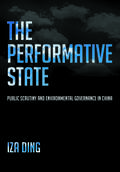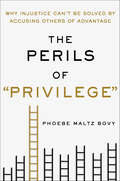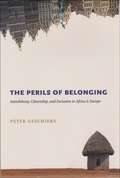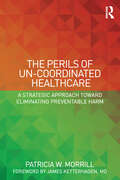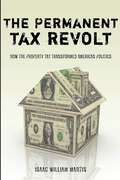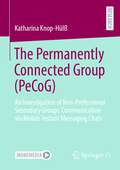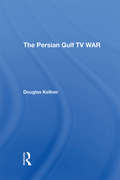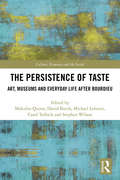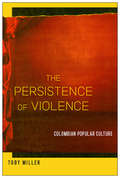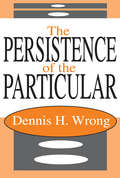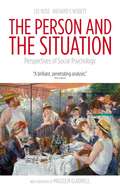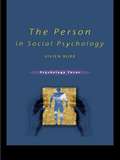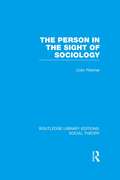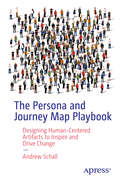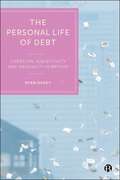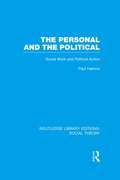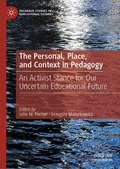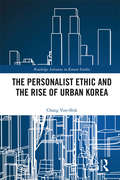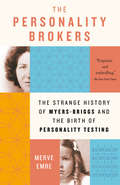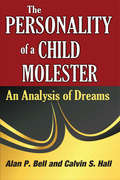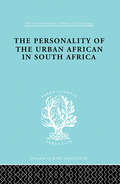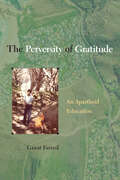- Table View
- List View
The Performative State: Public Scrutiny and Environmental Governance in China
by Iza DingWhat does the state do when public expectations exceed its governing capacity? The Performative State shows how the state can shape public perceptions and defuse crises through the theatrical deployment of language, symbols, and gestures of good governance—performative governance.Iza Ding unpacks the black box of street-level bureaucracy in China through ethnographic participation, in-depth interviews, and public opinion surveys. She demonstrates in vivid detail how China's environmental bureaucrats deal with intense public scrutiny over pollution when they lack the authority to actually improve the physical environment. They assuage public outrage by appearing responsive, benevolent, and humble. But performative governance is hard work. Environmental bureaucrats paradoxically work themselves to exhaustion even when they cannot effectively implement environmental policies. Instead of achieving "performance legitimacy" by delivering material improvements, the state can shape public opinion through the theatrical performance of goodwill and sincere effort. The Performative State also explains when performative governance fails at impressing its audience and when governance becomes less performative and more substantive. Ding focuses on Chinese evidence but her theory travels: comparisons with Vietnam and the United States show that all states, democratic and authoritarian alike, engage in performative governance.
The Performer: Art, Life, Politics
by Richard SennettAn acclaimed sociologist&’s exploration of the connections among performances in life, art, and politics In The Performer, Richard Sennett explores the relations between performing in art (particularly music), politics, and everyday experience. It focuses on the bodily and physical dimensions of performing, rather than on words. Sennett is particularly attuned to the ways in which the rituals of ordinary life are performances. The book draws on history and sociology, and more personally on the author&’s early career as a professional cellist, as well as on his later work as a city planner and social thinker. It traces the evolution of performing spaces in the city; the emergence of actors, musicians, and dancers as independent artists; the inequality between performer and spectator; the uneasy relations between artistic creation and social and religious ritual; the uses and abuses of acting by politicians. The Janus-faced art of performing is both destructive and civilizing.
The Perils of "Privilege": Why Injustice Can't Be Solved by Accusing Others of Advantage
by Phoebe Maltz BovyTop 50 Notable Works of Nonfiction in 2017–The Washington Post “Privilege”—the word, the idea, the accusation that is nearly impossible to disprove—is the new rhetorical power play. From social media to academia, public speech to casual conversation, the word is utilized to brand people of all kinds with a term once reserved exclusively for those who came from wealth and old money—inherited advantage.Today “privileged” applies to anyone who enjoys an unearned advantage in life, inherited or not. White privilege, male privilege, straight privilege—those conditions make everyday life easier, less stressful, more lucrative, and generally better for those who hold one, two, or all three designations. But what about white female privilege in the context of feminism? Or fixed gender privilege in the context of transgender? Or weight and height privilege in the context of hiring practices and salary levels? Or food privilege in the context of widening inequality for single-parent families?In The Perils of “Privilege,” Phoebe Maltz Bovy examines the rise of this word into extraordinary potency. Does calling out privilege help to change or soften it? Or simply reinforce it by dividing people against themselves? And is privilege a concept that, in fact, only privileged people are debating? The Perils of “Privilege” explores how this word is deployed, and offers ways to begin anew so many of the conversations it has silenced.
The Perils of Belonging: Autochthony, Citizenship, and Exclusion in Africa and Europe
by Peter GeschiereDespite being told that we now live in a cosmopolitan world, more and more people have begun to assert their identities in ways that are deeply rooted in the local. These claims of autochthony--meaning "born from the soil"--seek to establish an irrefutable, primordial right to belong and are often employed in politically charged attempts to exclude outsiders. In The Perils of Belonging, Peter Geschiere traces the concept of autochthony back to the classical period and incisively explores the idea in two very different contexts: Cameroon and the Netherlands. In both countries, the momentous economic and political changes following the end of the cold war fostered anxiety over migration. For Cameroonians, the question of who belongs where rises to the fore in political struggles between different tribes, while the Dutch invoke autochthony in fierce debates over the integration of immigrants. This fascinating comparative perspective allows Geschiere to examine the emotional appeal of autochthony--as well as its dubious historical basis--and to shed light on a range of important issues, such as multiculturalism, national citizenship, and migration.
The Perils of Un-Coordinated Healthcare: A Strategic Approach toward Eliminating Preventable Harm
by Patricia W MorrillDespite its frequency and its potential severity, preventable medical harm is still prominent in American hospitals and continues to put an alarming amount of lives at risk, being the third leading cause of death in the United States. Even some of the most commonly performed surgeries, such as knee and hip replacements, are resulting in a rapidly increasing rate of surgical site infections. Patricia Morrill’s book is specifically written for the healthcare industry. It fills the need for exposing how preventable harm is a systemwide problem and provides a step-by-step model to apply for raising process improvement to a strategic level. The approach is ideal for team training purposes. The Perils of Un-Coordinated Healthcare gives the reader both a personal and professional view of the impact of preventable medical harm, using case studies and observations on preventable deaths and healthcare practice alongside recommended research topics and resources. By looking at the work of both healthcare workers and their managing executives, this instructional text gives methods to assess workforces and self-assess the performances of managers. The book equips readers with a 360 view: patients, families, physicians, workforce, leaders and culture. Morrill’s ten-step model of Process Improvement Strategy Deployment integrates Lean and Project Management methodologies for developing a problem-solving culture and initiating process improvement at a strategic level. It is essential reading for those in the healthcare industry.
The Permanent Tax Revolt: How the Property Tax Transformed American Politics
by Isaac MartinTax cuts are such a pervasive feature of the American political landscape that the political establishment rarely questions them. Since 2001, Congress has abolished the tax on inherited wealth and passed a major income tax cut every year, including two of the three largest income tax cuts in American history despite a long drawn-out war and massive budget deficits. The Permanent Tax Revolt traces the origins of this anti-tax campaign to the 1970s, in particular, to the influence of grassroots tax rebellions as homeowners across the United States rallied to protest their local property taxes. Isaac William Martin advances the provocative new argument that the property tax revolt was not a conservative backlash against big government, but instead a defensive movement for government protection from the market. The tax privilege that the tax rebels were defending was in fact one of the largest government social programs in the postwar era. While the movement to defend homeowners' tax breaks drew much of its inspiration—and many of its early leaders—from the progressive movement for welfare rights, politicians on both sides of the aisle quickly learned that supporting big tax cuts was good politics. In time, American political institutions and the strategic choices made by the protesters ultimately channeled the movement toward the kind of tax relief favored by the political right, with dramatic consequences for American politics today.
The Permanently Connected Group (PeCoG): An Investigation of Non-Professional Secondary Groups’ Communication via Mobile Instant Messaging Chats
by Katharina Knop-HülßThe small group uniquely benefits from the ubiquitously available connective possibilities of mobile communication technologies. The group chat feature of mobile instant messaging applications (MIMAs, e.g., WhatsApp, Signal) provides small groups with a permanently accessible communication place where members can relay information to all others at once, independent of their spatiotemporal location. The resulting permanent collective addressability (PCA) of members has implications for group processes (e.g., group coordination, socio-emotional concerns of members). This book investigates the communicative activity in MIMA chats of 18 naturally occurring, goal-oriented groups in a non-professional setting using a standardized content analysis.It thus extends findings on individual-level expectations of permanent connectedness and shows how a group using such technology can be understood as a permanently connected group (PeCoG) and group-level manifestation of the hybridity of mediated and face-to-face communication constituting our current communication reality. Above all, this book demonstrates the potential of small group research to describe current phenomena relevant to communication science.
The Persian Gulf TV War
by Douglas KellnerDouglas Kellner's Persian Gulf TV War attacks the myths, disinformation, and propaganda disseminated during the Gulf war. At once a work of social theory, media criticism, and political history, this book demonstrates how television served as a conduit for George Bush's war policies while silencing anti-war voices and foregoing spirited discussion of the complex issues involved. In so doing, the medium failed to assume its democratic responsibilities of adequately informing the American public and debating issues of common concern. Kellner analyzes the dominant frames through which television presented the war and focuses on the propaganda that sold the war to the public–one of the great media spectacles and public relations campaigns of the post-World War II era. In the spirit of Orwell and Marcuse, Kellner studies the language surrounding the Gulf war and the cynical politics of distortion and disinformation that shaped the mainstream media version of the war, how the Bush administration and Pentagon manipulated the media, and why a majority of the American public accepted the war as just and moral.
The Persistence of Taste: Art, Museums and Everyday Life After Bourdieu (CRESC)
by Stephen Wilson Carol Tulloch Malcolm Quinn Dave Beech Michael LehnertThis book offers an interdisciplinary analysis of the social practice of taste in the wake of Pierre Bourdieu’s sociology of taste. For the first time, this book unites sociologists and other social scientists with artists and curators, art theorists and art educators, and art, design and cultural historians who engage with the practice of taste as it relates to encounters with art, cultural institutions and the practices of everyday life, in national and transnational contexts. The volume is divided into four sections. The first section on ‘Taste and art’, shows how art practice was drawn into the sphere of ‘good taste’, contrasting this with a post-conceptualist critique that offers a challenge to the social functions of good taste through an encounter with art. The next section on ‘Taste making and the museum’ examines the challenges and changing social, political and organisational dynamics propelling museums beyond the terms of a supposedly universal institution and language of taste. The third section of the book, ‘Taste after Bourdieu in Japan’ offers a case study of the challenges to the cross-cultural transmission and local reproduction of ‘good taste’, exemplified by the complex cultural context of Japan. The final section on ‘Taste, the home and everyday life’ juxtaposes the analysis of the reproduction of inequality and alienation through taste, with arguments on how the legacy of ideas of ‘good taste’ have extended the possibilities of experience and sharpened our consciousness of identity. As the first book to bring together arts practitioners and theorists with sociologists and other social scientists to examine the legacy and continuing validity of Pierre Bourdieu’s sociology of taste, this publication engages with the opportunities and problems involved in understanding the social value and the cultural dispositions of taste ‘after Bourdieu’. It does so at a moment when the practice of taste is being radically changed by the global expansion of cultural choices, and the emergence of deploying impersonal algorithms as solutions to cultural and creative decision-making.
The Persistence of Violence: Colombian Popular Culture
by Toby MillerColombia’s headline story, about the peace process with guerrilla and its attendant controversies, does not consider the fundamental contradiction of a nation that spans generosity and violence, warmth and hatred—products of its particular pattern of invasion, dispossession, and enslavement. The Persistence of Violence fills that gap in understanding. Colombia is a place that is two countries in one—the ideal and the real—summed up in the idiomatic expression, not unique to Colombia, but particularly popular there, "Hecha la ley, hecha la trampa" (When you pass a law, you create a loophole). Less cynically, and more poetically, the Nobel Laureate Gabriel García Márquez deemed Colombians capable of both the most noble acts and the most abject ones, in a world where it seems anyone might do anything, from the beautiful to the horrendous.The Persistence of Violence draws on those contradictions and paradoxes to look at how violence—and resistance to it—characterize Colombian popular culture, from football to soap opera to journalism to tourism to the environment.
The Persistence of the Particular
by Dennnis H. WrongDefinitions of human beings as "symbolic animals" emphasize our capacity to form theories and general laws that can be applied to common social experience. This is balanced by an equally strong will to define events and conditions that are particular to specific times, places, and individuals. In this volume, Dennis H. Wrong argues that the scientific standard of universal laws and propositions has only limited relevance to human historical phenomena.Wrong identifies the essential questions for social science as the place of nature and nurture in forming personality, the sources of variation in human conduct and culture, the causes of deviations from social norms, how human motivations are socially shaped and controlled to make society possible, and, finally, the causes of social change. Because successive generations of thinkers have given varying answers to these questions, no cumulative progress can be said to have occurred. Wrong argues that the unity of theory and research sought by American sociologists cannot be obtained in social theory.In terms of sociological practice, this has created a disparity between the canonical theories of Marx, Durkheim, and Weber, and the empirically oriented methodologies of current social research--especially questionnaires, fieldwork, and statistical research. Wrong attributes this disparity to postmodern skepticism about the potential of the social sciences to create a body of knowledge that might positively reshape human society. Between the large-scale theoretical constructs of classical theory and the overly particularistic tendencies associated with postmodernism, Wrong argues for a historically oriented approach emphasizing unforeseen, accidental agents as a foundation for modestly conceived theories.Wrong emphasizes that the capacity to avoid predictable, standardized responses, whether they are based on instinct or ingrained habit, is the source of human creativity. Homo sapiens is as m
The Person and the Situation: Perspectives of Social Psychology
by Richard E. Nisbett Lee RossHow does the situation we're in influence the way we behave and think? Professors Ross and Nisbett eloquently argue that the context we find ourselves in substantially affects our behavior in this timely reissue of one of social psychology's classic textbooks.
The Person in Social Psychology (Psychology Focus Ser.)
by Vivien BurrTraditional social psychology assumes that the person has an already-existing nature that then becomes subject to the influence of the social environment. The Person in Social Psychology challenges this model, drawing on theories from micro-sociology and contemporary European social psychology to suggest a more 'social' re-framing of the person. In this book Vivien Burr has provided a radical new agenda for students of social psychology and sociology. Using concepts familiar to the social psychologist, such as norms, roles, demand characteristics and labelling, she argues for an understanding of the person where the social world is not a set of variables that affect a pre-existing individual, but is instead the arena where the person becomes formed.
The Person in the Sight of Sociology (Routledge Library Editions: Social Theory)
by Colin FletcherSociology is about society, but what about people? The person in the sight of sociology is all too often a matchstick being. In this original and stimulating book the person is characterized by what is inherent in a social being, and the result is a rich narrative, the story of the person told through events in life. The author holds that for sociological purposes, the person must be seen as perfect: perfectible, perfecting and perfect. He outlines the ‘trialectical’ nature of such a theory, offers a test of it in the making of madness and claims that such a change in vision is appropriate for the sociologist’s critical engagement in the world. It may be claimed that Colin Fletcher has created a new realm of theorizing and a piece of literature for sociology. And, perhaps as important, the reader may catch the rare experience of being spoken with as a person by another person.
The Persona and Journey Map Playbook: Designing Human-Centered Artifacts to Inspire and Drive Change
by Andrew SchallMost personas and journey maps crash land shortly after takeoff. This step-by-step playbook provides a revolutionary approach to creating these pivotal artifacts in product design through the concept of altitudes. They will guide you in conceptualizing your users through research techniques that directly inform persona characteristics. Discover how to create personas that are free from irrelevant attributes and learn to develop high-altitude personas with sufficient lift to guide product roadmaps and organizational strategy. You'll also master constructing flight paths for journey maps that capture the user’s journey at the perfect level of detail, uncovering key moments in their experience. Then, as personas and journeys evolve, you will learn to measure the impact of product experience improvements. With this book as your co-pilot, you'll navigate the creation process with the help of templates and real-world examples reflecting the latest methods for personas and journey maps. The Persona and Journey Map Playbook will provide you with the tools and strategies to create impactful personas and journey maps that will drive user-centered design and product success. What You’ll Learn Integrate personas and journey maps into a cohesive user experience strategy. Gain practical details to design for users, avoiding common pitfalls of stereotyped and irrelevant personas. Utilize user research activities and synthesize insights to inform personas and journey maps. Understand the root causes of user experience issues through personas and journey maps to inform product roadmaps, create user requirements, and document future experiences. Who This Book Is For Product leaders, user experience designers, user researchers, or any roles responsible for understanding user needs.
The Personal Life of Debt: Coercion, Subjectivity and Inequality in Britain
by Ryan DaveyAs the cost of living rises, British households face unprecedented levels of debt. But many commentators characterise those who stash away envelopes, leave telephones ringing, or hide from debt collectors as irresponsible. The first full-length ethnography of debt problems in Britain, this book uses long-term fieldwork on a southern English housing estate to give a sensitive retelling of the everyday lives of indebted people. It argues that the inequalities of debt go beyond economic questions to include the way state coercion hinders people’s efforts to define what they truly value. Indeed, from finance to housing and even parenthood, the potential for dispossession has become a pervasive method of power that strikes at the heart of personal life.
The Personal and the Political: Social Work and Political Action (Routledge Library Editions: Social Theory)
by Paul HalmosAre human misery, poverty and despair a result of personal inadequacy or social injustice? Therefore is the solution to these problems psychotherapy or political action? In one of the most important books on social work for a decade, Paul Halmos tries to resolve a dilemma which many social workers experience acutely – the conflict between a desire to help those in need and a fear that, by doing so, they merely support a political system which should, itself, be changed. Such a dilemma was highlighted during the sixties when 'casework' and personal counselling became discredited by the 'rediscovery' of widespread poverty and inequality in western society. To many the only solution seemed to be urgent and radical political action. For Professor Halmos the realities are more complex – an exclusive preoccupation with either personal or political solutions is unlikely to prove fruitful – what is needed is a dual sensitivity and balance. Yet for the author it is the political solution which carries within it the greater risk and he warns of the dangers inherent in the total politicization of social concerns. He argues that social action can become political action and ultimately political control.
The Personal, Place, and Context in Pedagogy: An Activist Stance for Our Uncertain Educational Future (Palgrave Studies in Educational Futures)
by Grzegorz Mazurkiewicz John M. FischerThis edited volume includes contributions on education within a world of challenges by authors with diverse experiences and perspectives. Together, the authors reflect on educational initiatives and life in democratic societies, arguing for an increased awareness of the educational processes at work within our contexts, places, and personal lives. Chapters argue that authority and knowledge belong to everyone and that these are found on every level of perceived educational hierarchies. This book calls for attention to be paid to the voices of teachers in school, students in the classroom, participants in a project, and researchers embedded in a community—highlighting that they all have something to teach about understanding the world all are working to create in an uncertain educational future.
The Personalist Ethic and the Rise of Urban Korea (Routledge Advances in Korean Studies)
by Yunshik ChangThis book reviews South Korea’s experiences of kŭndaehwa (modernization), or catching up with the West, with a focus on three major historical projects, namely, expansion of new (Western) education, industrialization and democratization. The kŭndaehwa efforts that began in the last quarter of the nineteenth century have now fully transformed South Korea into an urban industrial society. In this book we will explore the three major issues arising from the kundaehwa process in Korea: How was the historical transformation made possible in the personalistic environment?; How personalistic is modern Korea?; And how difficult is it to build an orderly public domain in the pesonalistic modern Korea and how do Koreans respond to this dilemma of modernization? As an examination of modernization as well as Korea, this book will appeal to students and scholars of Korean studies, sociology, politics and history.
The Personality Brokers: The Strange History of Myers-Briggs and the Birth of Personality Testing
by Merve EmreAn unprecedented history of a personality test devised in the 1940s by a mother and daughter, both homemakers, that has achieved cult-like status and is used in today's most distinguished boardrooms, classrooms, and beyond.The Myers-Briggs Type Indicator is the most popular personality test in the world. It has been harnessed by Fortune 100 companies, universities, hospitals, churches, and the military. Its language--of extraversion vs. introversion, thinking vs. feeling--has inspired online dating platforms and BuzzFeed quizzes alike. And yet despite the test's widespread adoption, experts in the field of psychometric testing, a $500 million industry, struggle to account for its success--no less to validate its results. How did the Myers-Briggs test insinuate itself into our jobs, our relationships, our Internet, our lives? First conceived in the 1920s by the mother-daughter team of Katherine Briggs and Isabel Briggs Myers, a pair of aspiring novelists and devoted homemakers, the Myers-Briggs was designed to bring the gospel of Carl Jung to the masses. But it would take on a life of its own, reaching from the smoke-filled boardrooms of mid-century New York to Berkeley, California, where it was honed against some of the twentieth century's greatest creative minds. It would travel across the world to London, Zurich, Cape Town, Melbourne, and Tokyo; to elementary schools, nunneries, wellness retreats, and the closed-door corporate training sessions of today. Drawing from original reporting and never-before-published documents, The Personality Brokers examines nothing less than the definition of the self--our attempts to grasp, categorize, and quantify our personalities. Surprising and absorbing, the book, like the test at its heart, considers the timeless question: What makes you you?
The Personality Brokers: The Strange History of Myers-Briggs and the Birth of Personality Testing
by Merve Emre"Inventive and beguiling... The Personality Brokers is history that reads like biography that reads like a novel--a fluid narrative that defies expectations and plays against type." --New York Times"Riveting [and] far-reaching... [Emre] brings the skills of a detective, cultural critic, historian, scientist and biographer to bear on the MBTI and the two women who invented and promoted it" --Wall Street JournalAn unprecedented history of the personality test conceived a century ago by a mother and her daughter--fiction writers with no formal training in psychology--and how it insinuated itself into our boardrooms, classrooms, and beyondThe Myers-Briggs Type Indicator is the most popular personality test in the world. It is used regularly by Fortune 500 companies, universities, hospitals, churches, and the military. Its language of personality types--extraversion and introversion, sensing and intuiting, thinking and feeling, judging and perceiving--has inspired television shows, online dating platforms, and Buzzfeed quizzes. Yet despite the test's widespread adoption, experts in the field of psychometric testing, a $2 billion industry, have struggled to validate its results--no less account for its success. How did Myers-Briggs, a homegrown multiple choice questionnaire, infiltrate our workplaces, our relationships, our Internet, our lives? First conceived in the 1920s by the mother-daughter team of Katherine Briggs and Isabel Briggs Myers, a pair of devoted homemakers, novelists, and amateur psychoanalysts, Myers-Briggs was designed to bring the gospel of Carl Jung to the masses. But it would take on a life entirely its own, reaching from the smoke-filled boardrooms of mid-century New York to Berkeley, California, where it was administered to some of the twentieth century's greatest creative minds. It would travel across the world to London, Zurich, Cape Town, Melbourne, and Tokyo, until it could be found just as easily in elementary schools, nunneries, and wellness retreats as in shadowy political consultancies and on social networks.Drawing from original reporting and never-before-published documents, The Personality Brokers takes a critical look at the personality indicator that became a cultural icon. Along the way it examines nothing less than the definition of the self--our attempts to grasp, categorize, and quantify our personalities. Surprising and absorbing, the book, like the test at its heart, considers the timeless question: What makes you, you?
The Personality of a Child Molester: An Analysis of Dreams
by Calvin HallThe Personality of a Child Molester argues two main points. The first is that dreams, without free associations or amplification or knowledge of the dreamer, can shed considerable light upon the essential character structure, psychodynamics, and psychosexual development of such individuals. The second is that the frequency of occurrence of a dream element or theme is a direct measure of the preoccupation with that topic in waking life.Bell and Hall gather their evidence from a wide assortment of data. Such evidence helps increase our understanding of such people, whose life and self-revelations on first appearance seem to merit this special attention. Interestingly, their study involved little collaboration on the part of the authors. In fact, the authors only met each other two years after the project got underway. At that time they reached an understanding as to how the material would be presented.They decided to demonstrate child molesters' dream content from a theoretical perspective. The theoretical base provided by Freudian theory was used in this particular study because it seemed to provide the kinds of constructs that could be useful in describing the dreamer's personality. The authors attempt to explain why the dreamer who is a child molester is the sort of person he is, and his dreams are the source of evidence for the explanation presented. This study presented here has been used by behavioral researchers for years in trying to understand the personality of a child molester. It remains as relevant today as when it was initially published.
The Personality of the Urban African in South Africa (International Library of Sociology)
by C. de RidderFirst Published in 1998. Routledge is an imprint of Taylor & Francis, an informa company.
The Perversity of Gratitude: An Apartheid Education
by Grant FarredApartheid, ironically, provided Grant Farred with the optimal conditions for thinking. He describes South Africa’s apartheid regime as an intellectual force that, “Made thinking apartheid, more than anything else, an absolute necessity.” The Perversity of Gratitude is a provocative book in which Farred reflects on an upbringing resisting apartheid. Although he is still inclined to struggle viscerally against apartheid, he acknowledges, “It is me.” Unsentimental about his education, Farred’s critique recognizes the impact of four exceptional teachers—all engaging pedagogical figures who cultivated a great sense of possibility in how thinking could be learned through a disenfranchised South African education. The Perversity of Gratitude brings to bear the work of influential philosophers such as Martin Heidegger and Jacques Derrida. The book tackles broad philosophical concepts—transgression, withdrawal, and the dialectic. This leads to the creation of a new concept, “the diaspora-in-place,” which Farred explains, “is having left a place before one physically removes oneself from this place.” Farred’s apartheid education in South Africa instilled in him a lifelong commitment to learning thinking. “And for that I am grateful,” Farred writes in The Perversity of Gratitude. His autopoiesis is sure to provoke and inspire readers.
The Petite Bourgeoisie in Europe 1780-1914: Enterprise, Family And Independence (Routledge Library Editions: The Victorian World)
by Heinz-Gerhard Haupt Geoffrey CrossickFirst published in 1995. Geoffrey Crossick and Heinz-Gerhard Haupt provide a major overview of the social, economic, cultural and political development of the petite bourgeoisie in eighteenth-, nineteenth- and early twentieth-century Europe. Through comparative analysis the authors examine issues such as the centrality of small enterprise to industrial change, the importance of family and locality to the petit-bourgeois world, the search for stability and status, and the associated political move to the right. This title will be of interest to students of history.
